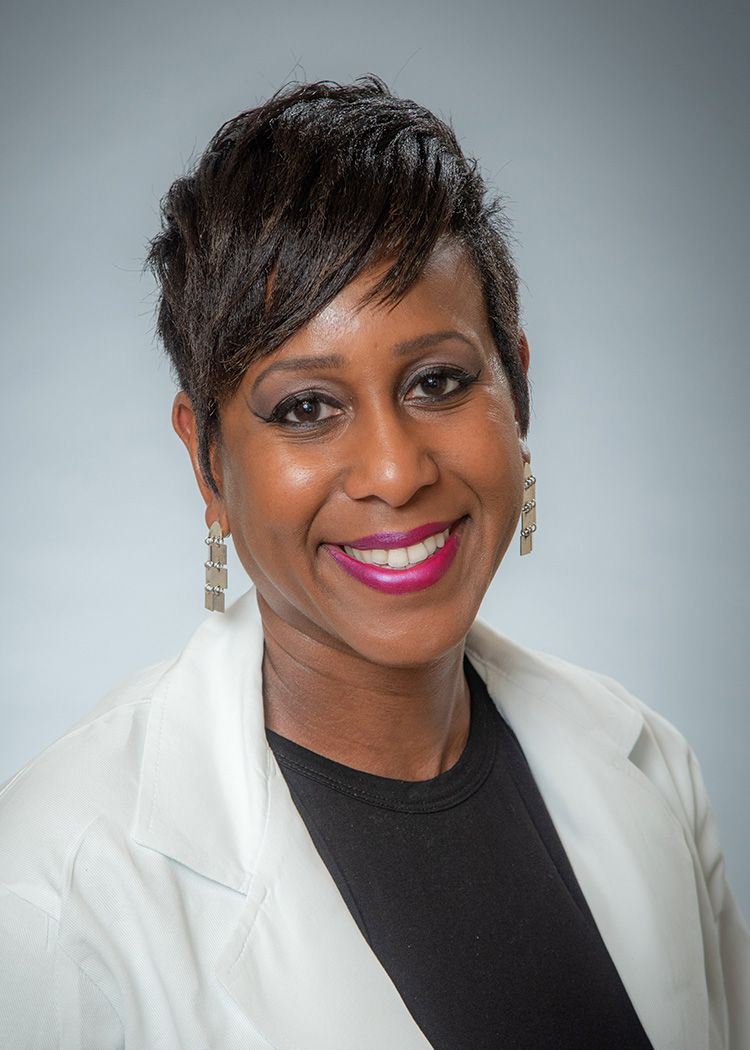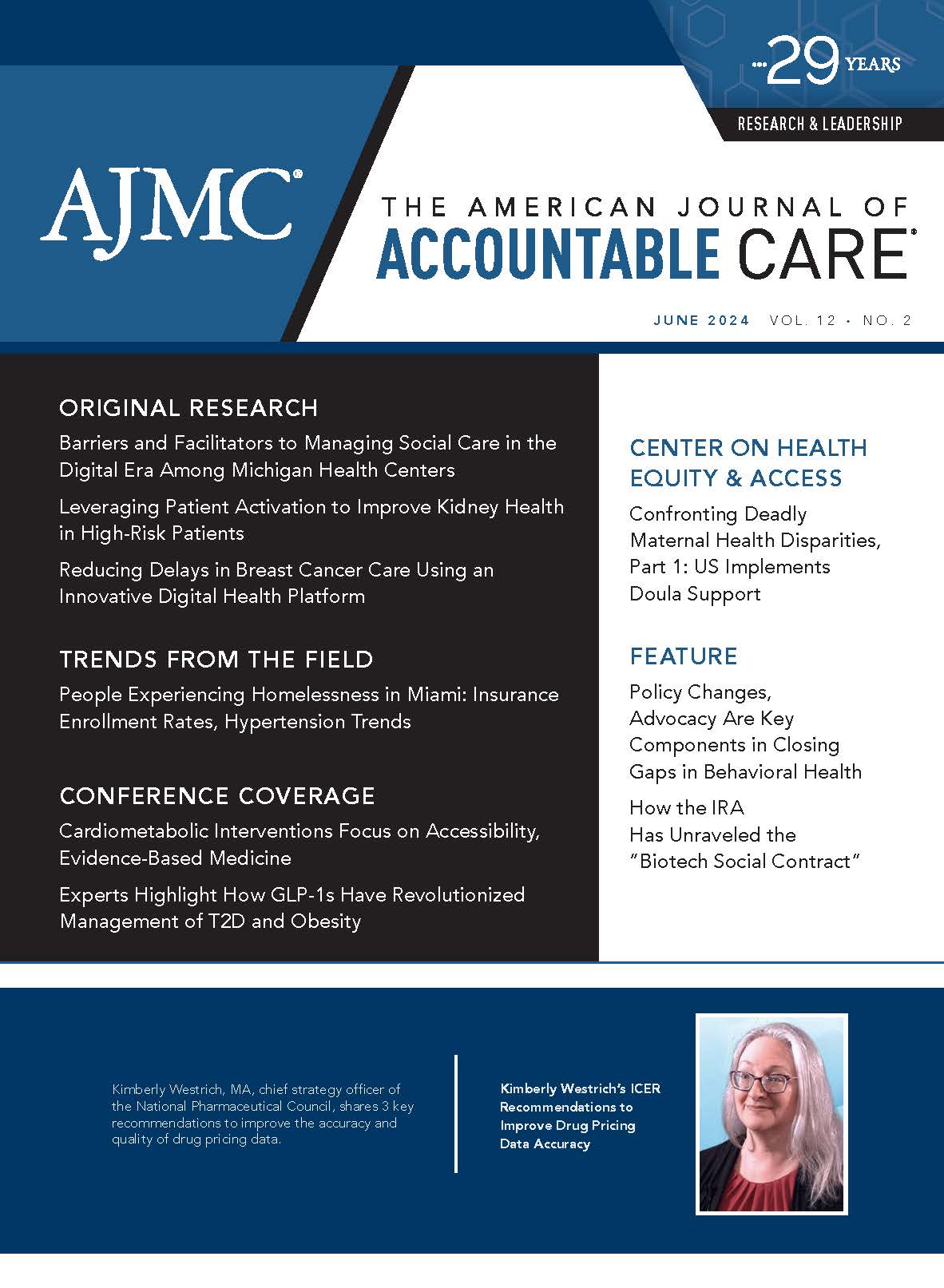- Center on Health Equity & Access
- Clinical
- Health Care Cost
- Health Care Delivery
- Insurance
- Policy
- Technology
- Value-Based Care
Confronting Deadly Maternal Health Disparities, Part 1: US Implements Doula Support
This feature series delves into how biases shed light on deeply ingrained stereotypes and prejudices that exist within the structure of US maternal health care, according to experts.
The American Journal of Accountable Care. 2024;12(2):50-53. https://doi.org/10.37765/ajac.2024.89573
Although increasing maternal morbidity and mortality rates in the US have been widely publicized, the cause is nuanced, especially considering the racial disparity in rates. According to the latest CDC report,1 which analyzed the rates in 2021, 32.9 per 100,000 of those who were pregnant and gave birth in the US died. This number has dramatically increased within the US in the past few years (from 20.1 to 23.8 in 2019 and 2020, respectively) and is the highest among developed nations.
The severity of the maternal mortality rate is significantly multiplied by 2.6 when removing White (26.6) and Hispanic (26.0) women from the equation: 69.9 deaths occurred for every 100,000 Black women who gave birth in 2021. These statistics have urgently made rounds throughout social media and news platforms, but how do these quantitative figures reveal themselves in real-world health care, and how will the US qualify them?
For many Americans, particularly women of color, this is an unfortunate but familiar trend. Veronica Gillispie-Bell, MD, MAS, head of Women’s Services at Ochsner Medical Center - Kenner, in Louisiana, and director of quality for women‘s services for Ochsner Health, elucidated the essential aspects at play in an interview with the Center on Health Equity and Access (CHEA).2
“For those of us [who] have been working on health equity—I’ve been in the space of working on health equity for many years—these findings are not surprising. We know this,” she explained. “We know that in particular for Black women, the cases have been more anecdotal if you think about…individuals all the way from Serena Williams to myself speaking of our experiences within the maternity health care space and not being heard. When you’re not heard, that means you’re not respected.”
Veronica Gillispie-Bell, MD, MAS

Gillispie-Bell was referring specifically to findings published by the CDC revealing that 20% of mothers with children younger than 18 years reported mistreatment while receiving maternity care for their youngest child.3 The rate increased to approximately 30% when looking at the reports of Black, Hispanic, and multiracial mothers, as well as those with public insurance or no insurance, according to the study.
The mention of Williams, an accomplished Black American tennis player, refers to her inpatient treatment during childbirth, which could have had fatal implications when her concerns were dismissed when she was struggling to breathe. Williams further insisted she needed a CT scan with contrast and intravenous heparin. Only after being dismissed for being “confused” on pain medication and undergoing an ultrasound of her legs was her request for a CT scan fulfilled, revealing she had multiple blood clots in her lungs.4
Implicit bias in health care is one of the primary contributors to this issue, Gillispie-Bell stated. “Implicit bias, or unconscious bias, is the attitude and behaviors we demonstrate toward individuals,” she said in a written interview with CHEA.
“It is important to understand that implicit bias is unconscious—that fact makes it so much harder to address,” she continued. “Our brains are inundated with the amount of information that is coming to us at one time. Our brain takes shortcuts to process all of this information. The shortcuts are created by our social conditioning. Unfortunately, the social conditioning and stereotypes of Black women are not positive and can impact how we, as providers, deliver care.”
Findings from a study of more than 400 graduate students demonstrated a concerning disparity in perceptions between Black and White women.5 Gillispie-Bell explained that these findings indicated the students believed Black women were more inclined to have multiple sexual partners within a month, less likely to use birth control, and less likely to adhere to medical advice compared with White women.
“With those biases, it is not surprising that Black women do not receive equitable care,” she said.
Such biases shed light on deep-seated stereotypes and prejudices that exist within the US, she said. Consequently, these biased perceptions can lead to unequal treatment in health care settings, contributing to the systemic challenges faced by Black women in accessing equitable care.
“To address this issue, it is important for each health care provider to understand and acknowledge that they have biases. We all do,” Gillispie-Bell said. “I encourage providers to uncover their bias by taking the Harvard Implicit Association Test.”
Patricia Devine, PhD, Kenneth and Mamie Clark Professor of Psychology at the University of Wisconsin-Madison and director of the Prejudice and Intergroup Relations Lab, helped develop an interactive workshop that includes the test. Devine has researched implicit biases and strategies for mitigating them, and her work has been grounded in evidence-based data, suggesting that specific interventions can modify biases, including the following5:
- Replacing stereotypes: Consciously challenge and replace biased stereotypes with more accurate and inclusive perceptions.
- Using counterstereotypic imaging: Encourage individuals to actively imagine scenarios that contradict stereotypes, helping to reshape cognitive associations.
- Seeing people as individuals: Emphasize the importance of recognizing each person‘s unique qualities and characteristics rather than categorizing them based on preconceived notions.
- Taking a different perspective: Practice empathy by attempting to understand others’ experiences and viewpoints, fostering greater sensitivity and understanding.
- Increasing opportunities for interaction: Promote exposure to individuals from diverse backgrounds, races, and ethnicities, facilitating greater awareness and acceptance of diversity.
“I am concerned about the ability to sustain these efforts to address implicit bias, and medical mistreatment as words such as equity, privilege, and bias have been politicized. We have seen the forced resignation of several DEI [diversity, equity, and inclusion] leaders, most recently, Sherita Golden, [MD,] at Johns Hopkins [Medicine in Baltimore, Maryland], and in Alabama, Gov [Kay] Ivey signed a bill that prohibits using state funds for DEI programs and offices at state agencies, public entities, and higher education institutions,” Gillispie-Bell wrote. “Systemic racism comes from public policies that systematically and intentionally reinforce inequities.”
Highest Maternal Mortality in the Developed World
When assessing the disparities within maternal health care in the US compared with the rest of the developed world, Claude Pinnock, MD, MPH, chief medical officer of Wider Circle, said it comes down to “sick care vs health care.” In general, Americans tend to be less healthy, therefore entering pregnancy with comorbidities.
“This exists in every country where we overly anchor on when a member, or person, gets sick vs when they’re well,” he explained in an interview with CHEA. “But [the US systems] really have fewer financial incentives and structures in place, compared [with] other countries, to promote good primary prevention and public health to stop folks from even getting some of these comorbidities in the first place.”
Claude Pinnock, MD, MPH

The pivotal role of primary care and prevention for those who are pregnant was echoed by Randa Deaton, vice president of purchaser engagement at the Purchaser Business Group on Health, in a written interview with CHEA. “It’s important for pregnant people to have access to timely advanced primary care that is integrated with their maternal care team to ensure care is coordinated,” she explained. “We know that mental health in the postpartum period is a huge driver of maternal mortality, and primary care can ensure that new mothers are being screened and treated for depression and substance use disorder.”
In emphasizing the national practice of treating illness rather than preventing it, Pinnock further underscored the importance of access to health care, particularly for marginalized communities, and lamented the lack of financial reimbursement for addressing social determinants of health, which disproportionately affects Medicaid enrollees.
“If you look at the most basic health outcomes, life expectancy, and the cost to deliver it in the US, those don’t do so well—there’s one structural issue,” he said. “And there’s another issue around access and the availability of insurance, particularly [for those] who are less financially flush. Poor access to insurance, obviously, a lack of access to [health] care, vs having a universal health care system, is going to cause some of those disparities to get magnified.”
Pinnock, originally from the United Kingdom (UK), highlighted key differences he’s observed in maternity care in each country, including the benefits of a single-payer health care system that provides universal access and ultimately eliminates financial barriers to care. However, he especially emphasized the difference in approach to childbirth.
“Something I have noticed in the US is an extreme overmedicalization of childbirth,” he said. “In the UK, virtually all births are midwife-driven. You don‘t have an [obstetrician-gynecologist] present at birth—you have a midwife, or a doula, or the equivalent.”
The maternal mortality rate in the UK from 2020 to 2022 was 13.41 per 100,000 maternities (95% CI, 11.86-15.10), according to the National Perinatal Epidemiology Unit at the University of Oxford.6 Although this rate has increased from 11.66 (95% CI, 10.23-13.23) from 2019 to 2021, the difference was insignificant (rate ratio [RR], 1.15; 95% CI, 0.96-1.37; P = .114).
Midwives and doulas playing a central role in the birthing process in the UK stands in contrast to the US, where the maternal mortality rate is more than twice that of the UK (before even factoring race) and childbirth is often characterized by overmedicalization, with obstetrician-gynecologists typically leading the process. Pinnock suggested that this overmedicalization may lead to unnecessary interventions and complications, particularly for low-risk pregnancies.
In addition to the UK health care system taking a more holistic approach, Pinnock pointed out that maternity care in the UK focuses on community support and education, referencing the National Childbirth Trust (NCT). NCT provides comprehensive prenatal classes and support to expectant mothers and their families, which fosters a sense of community and trust among participants, extending beyond childbirth into the postnatal period.
As the chief medical officer of Wider Circle, which describes itself as “a neighborhood-based health organization that empowers members of the same community to live happier, healthier lives,” based in Redwood City, California, Pinnock shared that the maternity program emulates the NCT program by emphasizing the importance of community.
“When I think of things that are lacking or absent in the US, it’s all about trust, and communities need to trust health care, and vice versa. Providers need to trust what their patients are saying,” he explained. “[In the US], we don’t have that level of community building around maternal health, and I think that‘s actually something that’s…low cost and potentially high value in terms of the impact it can have, not just in the immediate prenatal [or] perinatal period but in the postnatal period as well.”
The high prevalence of pregnancy-related fatalities in the US has given rise to numerous initiatives across the country to improve care and amend disparities. In particular, doula support during and after pregnancy is being increasingly acknowledged as a method of mitigation.
“Women who have the care of a doula have fewer [cesarean deliveries], they have less postpartum depression, they tend to have normal birth weight pregnancies as opposed to low birth weight, [and] they tend to have fewer preterm deliveries,” Elizabeth Warner, MD, chief medical officer at Capital District Physicians Health Plan (CDPHP), said in an interview with CHEA.
Elizabeth Warner, MD

With these benefits, exhibited in research, incorporating doula coverage was a “no-brainer” for CDPHP, according to Warner. It’s available to eligible commercial, fully insured members. Members pay up front for doula services and are reimbursed by CDPHP for up to $1500. This benefit covers prenatal visits, labor support, and postpartum assistance from the doula. Members have flexibility in selecting their doula based on personal preferences and can include either live or virtual visits.
She acknowledged there are still limitations to the benefit because the financial barriers relating to up-front payment may hinder accessibility, but as the program is still in its early stages, the aim was to lay some groundwork and prove its effectiveness with the ongoing goal of improving access.
In line with Pinnock’s perspective, Warner underscored the importance of community engagement and education for optimal maternal health. CDPHP partners with Ovia Health, a company specializing in digital patient engagement that extends beyond pregnancy to include topics such as fertility and menopause. “Our goal is to have a comprehensive program here that supports people during their pregnancy, and doulas are just one part of it,” Warner said.
Since 2018, legislative efforts and related initiatives of Medicaid coverage for doula care have increased consistently each subsequent year, according to the National Health Law Program’s Doula Medicaid Project.7 In 2023, there was a great expansion in access to doula care, not only within Medicaid programs but also in the realm of private insurance.
Michigan, California, Oklahoma, and Massachusetts introduced Medicaid coverage for doula care in 2023, and Michigan, California, and Massachusetts also issued statewide orders for Medicaid coverage of doula care for all pregnant Medicaid enrollees. Minnesota followed suit in January 2024. Additionally, several states introduced legislation aimed at securing private insurance coverage for doula care, with Louisiana being the sole state to enact such legislation.
Currently, a significant number of states are actively pursuing efforts to implement statewide Medicaid coverage for doula care. A total of 43 states and Washington, DC, have implemented Medicaid coverage for doula care, are in the process of doing so, or have undertaken related actions. Only a handful of states remain where the Doula Medicaid Project has not identified any ongoing state-funded or state-organized endeavors to expand access to doula care.
Could Doula Coverage Be the Answer?
Although the national average maternal mortality rate of 32.9 per 100,000 births is concerning in itself, the stark racial disparities (for Black women, the rate is 69.9) and the implications that accompany them are especially harrowing. Unfortunately, their pervasiveness extends to maternal mental health as well.
Research results published in April 2024 in Health Affairs found significant racial and ethnic disparities in postpartum depressive symptom management among new mothers.8 Although diagnosis rates were similar across groups, Asian, Native Hawaiian, Pacific Islander, Southwest Asian, Middle Eastern, North African, Hispanic, and Black respondents were significantly less likely to access mental health care compared with White respondents.
Only 25.4% of patients with depressive symptoms reported a perinatal mood and anxiety disorder diagnosis, and 52.8% received postpartum mental health care.8 The study results highlighted the impact of racism on increasing stress and depressive symptoms and emphasized the need for policies mandating universal mental health screening, ensuring care access, reducing insurance coverage gaps, and providing culturally responsive clinician training to address postpartum mental health disparities.
However, it seems the benefit offered by doula support during pregnancy has the potential to fill many of these gaps in care, at least in part. A recent comprehensive evaluation of doula programs demonstrated effectiveness at reaching women enrolled in Medicaid managed care plans, particularly those who could benefit most from such services.9 The evaluation indicates that these programs cater to a higher proportion of Black women and women in regions with limited access to obstetrician-gynecologists and certified midwives.
This research found that despite facing more pregnancy complications, women engaging with doulas experienced better overall outcomes, including lower rates of cesarean deliveries and higher rates of vaginal births after cesarean delivery. Those receiving doula care exhibited a higher prevalence of postpartum visits, which are essential for detecting postpartum complications. The researchers noted initiating prenatal doula care in the first trimester was associated with a lower prevalence of postpartum anxiety and depression.
Results from another new study found that extending pregnancy-related Medicaid eligibility in Colorado from 60 days to 12 months revealed an association with significant increases in mental health treatment utilization.10 Compared with enrolling in commercial insurance, retaining Medicaid coverage resulted in higher rates of prescription medication and outpatient mental health treatment utilization. Additionally, it was linked to reduced out-of-pocket spending for mental health care and prescription medications for anxiety or depression.
The stark reality of maternal mortality rates in the US underscores the obligation for employers to address the critical demand for equitable access, Deaton stated in her recent presentation at the Greater Philadelphia Business Coalition on Health 2024 Women’s Health Conference.11
Randa Deaton

“I would argue that if you are purchasing for half of Americans, you have a responsibility to purchase equitable care on behalf of all of your workers and families,” she said.
According to Pinnock, the responsibility of addressing the maternal health crisis in the US falls heavily on state governments. Many health plans are working on this issue in silos, so he recommended establishing health plan collaboratives within each state. If the state government were to facilitate the formation of these collaboratives, it could provide shared infrastructure, access, and strategies to elevate efforts.
However, he also emphasized that the ever-present demand for financial incentives is something that cannot be ignored.
“What I have observed in general in life is that if the money doesn’t flow, things don’t tend to change,” he said. “So I would make it extremely financially painful to not do something about it in this space [of maternal health]...because if you were to do that, you better believe that the amount of attention and money and effort would increase accordingly.”
This is Part 1 of a multipart series featured exclusively on the Center on Health Equity and Access.
References
- Hoyert DL. Maternal mortality rates in the United States, 2021. CDC. Updated March 16, 2023. Accessed March 26, 2024. https://www.cdc.gov/nchs/data/hestat/maternal-mortality/2021/maternal-mortality-rates-2021.htm#fig1
- Grossi G. Dr Veronica Gillispie-Bell addresses racial disparities in maternity care. AJMC. August 28, 2023. Accessed March 26, 2024. https://www.ajmc.com/view/dr-veronica-gillispie-bell-racial-disparities-maternity-care
- Mohamoud YA, Cassidy E, Fuchs E, et al. Vital Signs: maternity care experiences — United States, April 2023. MMWR Morb Mortal Wkly Rep. 2023;72(35):961-967. doi:10.15585/mmwr.mm7235e1
- Lockhart PR. What Serena Williams’s scary childbirth story says about medical treatment of Black women. Vox. January 11, 2018. Accessed March 27, 2024. https://www.vox.com/identities/2018/1/11/16879984/serena-williams-childbirth-scare-black-women
- Devine PG, Forscher PS, Austin AJ, Cox WTL. Long-term reduction in implicit race bias: a prejudice habit-breaking intervention. J Exp Soc Psychol. 2012;48(6):1267-1278. doi:10.1016/j.jesp.2012.06.003
- Maternal mortality 2020-2022. Oxford Population Health NPEU. Updated January 10, 2024. Accessed March 27, 2024. https://www.npeu.ox.ac.uk/mbrrace-uk/data-brief/maternal-mortality-2020-2022#:~:text=If%20these%20women’s%20deaths%20attributable,1.39%2C%20p%3D0.152
- Chen A. Doula Medicaid Project: February 2024 state roundup. National Health Law Program. February 21, 2024. Accessed March 27, 2024. https://healthlaw.org/doula-medicaid-project-february-2024-state-roundup/
- Haight SC, Daw JR, Martin CL, et al. Racial and ethnic inequities in postpartum depressive symptoms, diagnosis, and care in 7 US jurisdictions. Health Aff (Millwood). 2024;43(4):486-495. doi:10.1377/hlthaff.2023.01434
- Doula access through Medicaid managed care improves maternal health. Elevance Health. February 2024. Accessed March 27, 2024. https://www.elevancehealth.com/public-policy-institute/doula-access-through-medicaid-managed-care-improves-maternal-health
- Gordon SH, Lee S, Steenland MW, Deen N, Feinberg E. Extended postpartum Medicaid in Colorado associated with increased treatment for perinatal mood and anxiety disorders. Health Aff (Millwood). 2024;43(4):523-531. doi:10.1377/hlthaff.2023.01441
- Grossi G. The pivotal role of payers in improving health equity, maternal health care in the US. AJMC. March 26, 2024. Accessed March 27, 2024. https://www.ajmc.com/view/the-pivotal-role-of-payers-in-pushing-for-health-equity-improving-maternal-health-care-in-the-us


